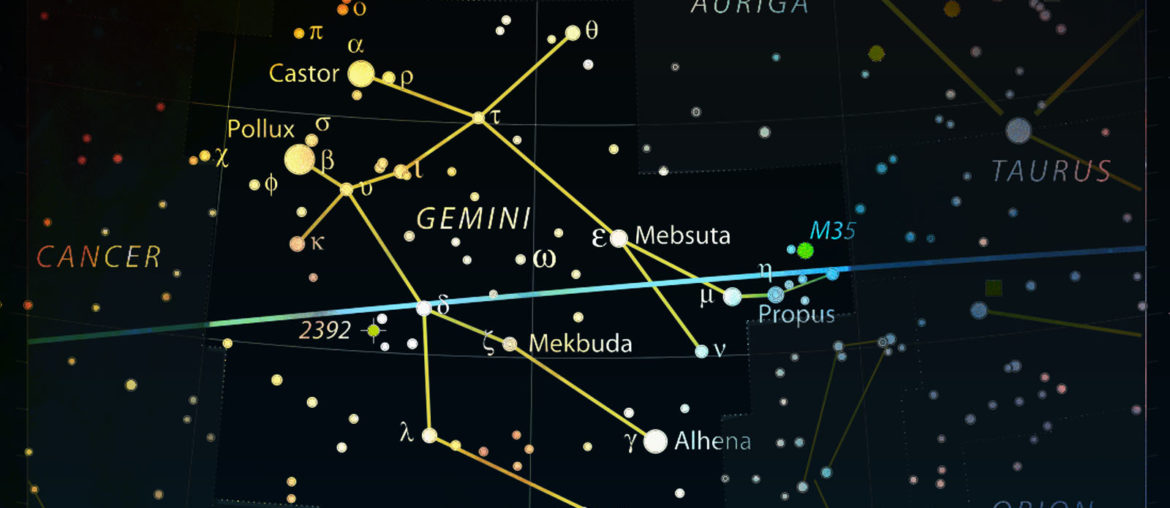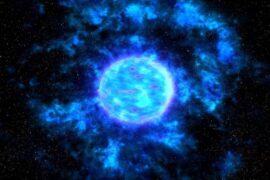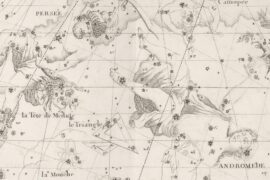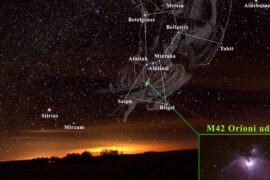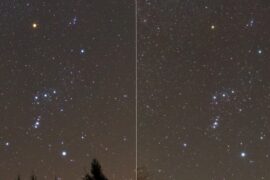A constellation is a group of stars that form some kind of shape in the sky. The old civilizations assigned names to these constellations and wrote myths and stories about them. In modern times we know a lot more about them and the stars that compose them. In this article, we will take a look at the Gemini constellation.
Gemini is one of the twelve zodiac constellations and one of the original 48 constellations the Greeks originally recognized. In modern days we have 88 constellations and Gemini is still one of them.
Gemini is most recognizable in culture because it is one of the twelve constellations that form the zodiac. The zodiac is an imaginary belt of constellations that seem to move during the year as Earth orbits around the Sun. The Greeks believed it was the Sun that was moving around these constellations and believed the position of the Sun in these constellations had an effect on people depending on where it was at the time they were born, but now we know it is Earth the one that is moving around and the twelve constellations just happen to be similarly aligned with our orbit.
The constellation has two main bright stars, Castor and Pollux, the twins that inspired Gemini’s name.

Gemini Fact Sheet
| Astronomical abbreviation | Gem |
| Named after | Castor and Pollux, the twins |
| Main stars | 17 |
| Total stars | 85 |
| Brightest star | Pollux, also known as beta Gem |
| Area | 514 square degrees |
| Quadrant | NQ2 |
| May 21 – June 21 | |
| Bordering constellations | Taurus Cancer Orion Lynx Auriga Monoceros Canis Minor |
| Meteor showers | Geminids, Rho Geminids |
| Symbol | ♊ |
Interesting Facts about Gemini
Gemini is a very interesting constellation with some unique characteristics. Here’s a list of cool facts that will help you with your class presentation or to impress someone while stargazing.
- The two brightest stars in Gemini are Castor and Pollux, also known as the twins.
- Even though they are referred to as the twins, Castor and Pollux were only half-brothers in Greek mythology.
- The stellar designations for Castor and Pollux are switched. When they were getting their scientific name (Alpha Gem and Beta Gem respectively) the astronomer Johann Bayer didn’t correctly measure their brightness. Castor got the “Alpha” name which is usually reserved for the brightest star. In reality, Pollux is the brightest star and should have gotten that name.
- Even though the zodiac dates for Gemini go from May 21st to June 21st, the actual dates the Sun “passes” by the constellation are June 20 to July 20.
- The best months to see Gemini are January and February when it is right overhead in the night sky.
- Castor is actually not just one star. It is a sextuple star system which appears to be a single star to us without very specialized equipment.
- The six stars in Castor are organized in three pairs of two stars each circling around each other.
- Of these six stars, two of them are about 3 times bigger than our Sun and two of them are about half the size of the Sun.
- Only eleven of all the stars in Gemini have proper names. The rest only have scientific (stellar) names.
- Pollux is located about 34 light years away, making it the closest giant star to Earth.
- It was recently discovered Pollux has one planet orbiting around it. This planet has been named Thestias.
- Around December 13-14 every year a meteor shower happens in the sky area of Gemini. It has been called the Geminids and has a maximum rate of 100 meteors per hour. It is a great show to watch.
Mythology
Gemini is one of the few constellations after more than one character. Its name in Latin means twins and is named after the legend of Castor and Pollux, two half-brothers in Greek mythology. They were both sons of Leda but had different fathers. Castor was the son of the king of Sparta while Pollux was the son of the Greek god Zeus.
It seems weird the Greeks would call the constellation “the twins” when they weren’t actually twins, right? Well, the actual origin of the name probably comes from Babylonian astronomy where the constellation was associated with the minor gods Meshlamtaea and Lugalirra who really were twins.
In Greek mythology, Pollux was a demigod (half-mortal, half-god) since he was a son of Zeus and was therefore immortal. When Castor was killed, Pollux asked Zeus to share his immortality so he could be with his brother so Zeus put them both in the sky as stars.
The twins also play an important role in the original myth of Helen of Troy. Castor and Pollux were half brothers of Helen and when she is abducted by the king of Athens, Theseus, they go on a quest to retrieve her and succeed. As revenge, they also take Theseus’ mother and make her a servant of Helen as punishment.
In Chinese astronomy, the stars that form Gemini are part of two different constellations. Some are part of Xī Fāng Bái Hǔ (The White Tiger) and others are part of Nán Fāng Zhū Què (The Vermillion Bird).
Main stars in Gemini
Gemini is mostly recognized for its two main twin stars which are very recognizable features of the night sky in the first few months of the year. Beyond that Gemini doesn’t have many bright stars which might make it difficult to mentally draw its shape. Let’s take a look at the data for some of the main stars in the constellation.
The magnitude of a star is basically its brightness. The radius is defined compared to the Sun so for example, if a star has a radius of two Solar Radius, it means it is twice as big as our Sun. The list is sorted by brightness.
| Proper Name | Stellar Designation (Name) | Type of star | Distance (in light years) | Radius |
| Pollux | Beta Gem | Giant Star | 33.78 | 8.8 |
| Castor | Alpha Gem | Six star system | 51 | 0.5 to 3.3 |
| Alhena | Gamma Gem | Evolving star | 109 | 3.3 |
| μ Gem | Mu Gem | – | 230 | 80 |
| Mebsuta | Epsilon Gem | Supergiant star | 840 | 140 |
| Propus | Eta Gem | Three star system | 380 | 1.18, 2.06, 153 |
| Alzirr | Xi Gem | – | 58.7 | 2.7 |
| Wasat | Delta Gem | Three star system | 60.5 | – |
Other objects found in Gemini
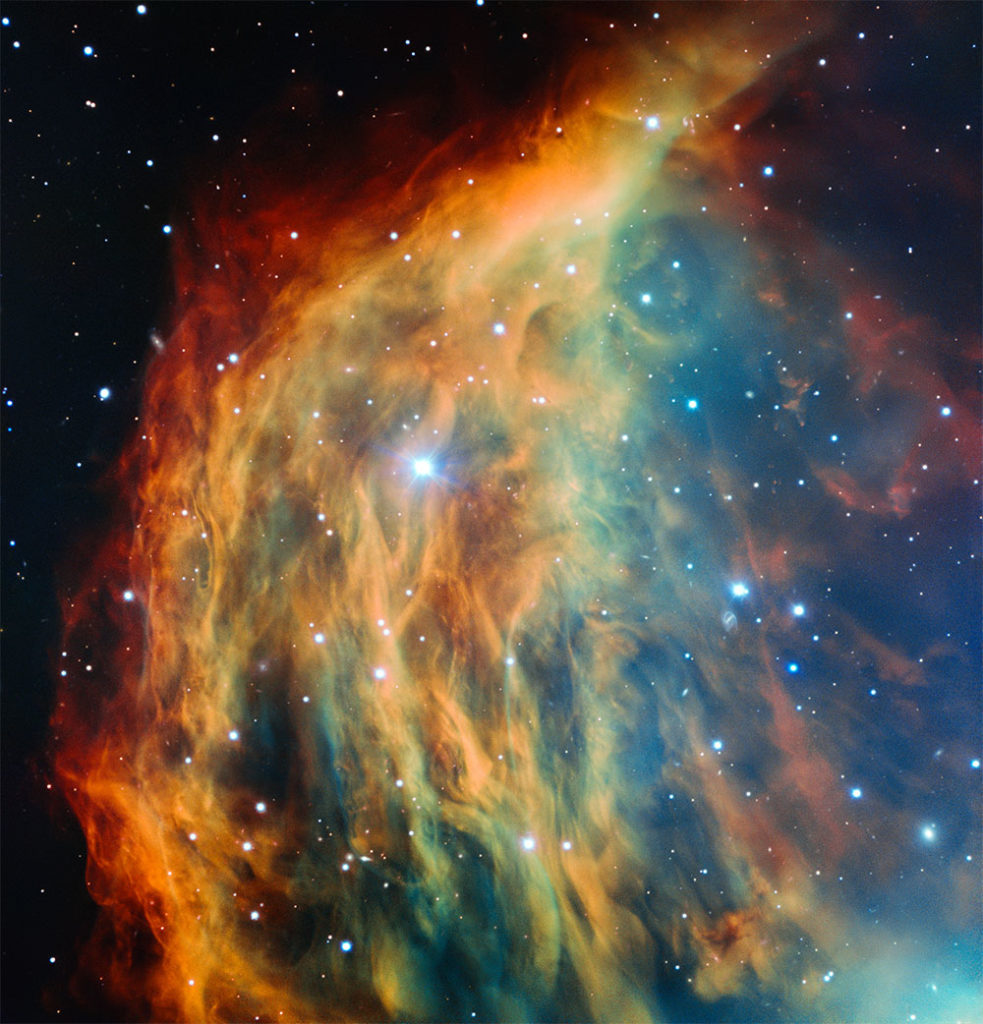
The Gemini constellation is home to a few other objects. While they don’t officially form part of the constellation, it is said they are in it because they can be seen in the same area.
First, there is a star cluster named M35. A cluster is a big group of hundreds or even thousands of stars that were created from the same cloud and therefore are very close and very similar to each other. M35 can be seen from Earth without the help of a telescope under very dark skies.
There are two nebulas in Gemini as well. The Eskimo Nebula, also known as the Clown Face Nebula, and the Medusa Nebula. Both can be observed with amateur telescopes from Earth under good sky conditions.
When Earth’s orbit passes through a certain area filled with bits of dust, rock, and ice left by a comet a meteor shower occurs. Depending on the area of the sky where they happen they receive a name based on the constellation that is in the are at the time. Around December 13 a meteor shower happens around Gemini so this event receives the name of Geminids. The Geminids are some of the most spectacular meteor showers that can be seen from Earth because they usually have thousands of meteors per hour. The comet responsible for the trail of meteors that composes the Geminids is called 3200 Phaethon. If you want to learn more about how meteor showers are created check out our comets explained article.
How to Find Gemini in the Night Sky
Locating Gemini in the sky is really easy as it thankfully neighbors some of the most recognizable constellations.
Gemini can be found in the night sky from December to June, but the best months to catch it are January and February as it is almost overhead. At this point, it is really easy to find as you only have to look for the two very bright twin stars really close to each other.
Besides that, there are two really easy ways to locate Gemini.
First, try to find the Orion constellation. Orion is extremely easy to find as you only have to look for Orion’s belt, which is three very recognizable stars in a straight line. Once you find Orion, draw an imaginary diagonal line from his right foot (the brightest star in it) to the star Betelgeuse which is easily recognizable because it is red-ish in color.
That line in the direction to Betelgeuse will point to Gemini. Simply look for the two bright stars close to each other, those are Castor and Pollux.

The second method involves finding the “Big Dipper”. While not an official constellation most people know how to recognize it as it looks, well, like a dipper. It is also easy to locate by finding which way is North as it is pretty much in that direction. Once you have it, draw an imaginary diagonal from the start of the handle (this star is named Megrez) to the star at the bottom end of the dipper (this one is Merak). The line will point straight to Pollux.
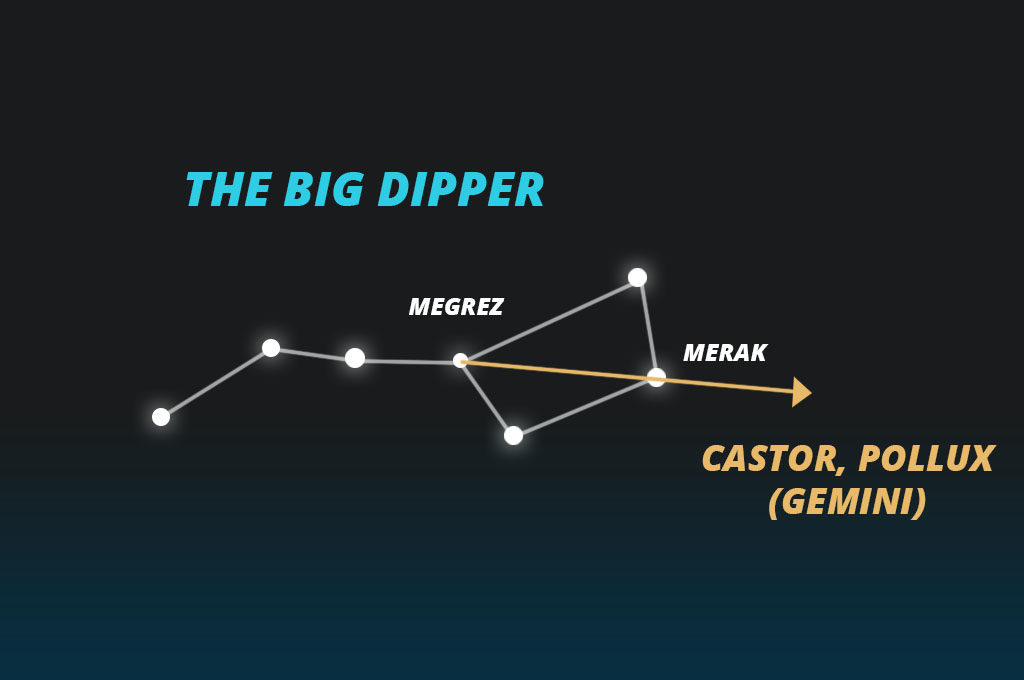
If you want a more precise and scientific way to locate it and you know your stellar navigation, it can be found at.
Right ascencion: 7 hours
Declination: +20°
Quadrant: NQ2
Latitudes where it is visible: +90° to −60°
Celebrities born under Gemini
Even though astrology is not a real science, it is kind of fun to know a trivial fact or two about it. If you were born under Gemini here’s a list of celebrities with whom you share the zodiac sign.
- Marylin Monroe, actress.
- Kanye West, musician
- Novak Djokovic, tennis player
- Angelina Jolie, actress
- John F. Kennedy, 35th president of the United States
Where to learn more
You can read more about the myth of Castor and Pollux on mythology.net
Here’s a list with every star in Gemini and the scientific data we know about them.
Enjoyed this article?
Get daily 10-minute PDFs about astronomy to read before bed!
Sign up for our upcoming micro-learning service where you will learn something new about space and beyond every day while winding down.

